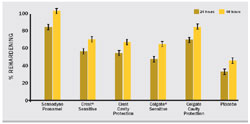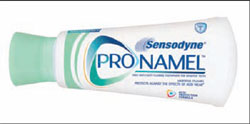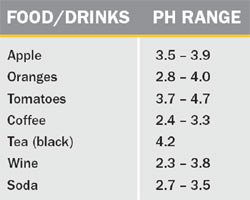New Sensodyne Pronamel: Tooth Wear—A Growing Issue
The longevity of the natural dentition has been extended for many people, thanks to the huge advances in dentistry made in the 20th century. Treatments for caries and periodontal diseases have been introduced, and as a result fewer teeth are being restored or extracted due to these diseases. However, dental professionals are now seeing patients whose teeth are showing signs of increasing tooth wear.1
Tooth wear is strongly linked to the consumption of acidic foods and drinks. These demineralize and soften the tooth surface, making it more susceptible to abrasion, particularly by brushing.1,2 Modern diets are often rich in acids from a wide range of sources. Notably, many fruits, fruit juices, and carbonated drinks—including the sugar-free variants2—have a low pH. A pH of 5.5 or below is sufficient to soften and demineralize enamel surfaces, and a pH of 6.5 or below can soften dentin.1 Though enamel softening caused by acids is normally mitigated by the natural calcium in saliva, frequent or prolonged acidic encounters leave less time for remineralization to occur. In this weakened state, surface enamel is prone to wear from the abrasive action of toothpaste and toothbrushing.1
In its early stages, tooth wear is often not addressed. However, as it progresses, tooth wear can result in a loss of enamel surface and dentin hypersensitivity.3 At any stage of tooth wear, dentin hypersensitivity may occur. This could range from infrequent twinges during consumption of hot, cold, or sweet foods to fairly continuous sensitivity readily provoked by the mildest of stimuli. Occasional sensitivity may go unreported by the patient during routine examinations.
Many people remain unaware of the consequences of tooth wear and the measures that can be taken to protect teeth from this slow and insidious process. Currently, tooth wear normally only reaches a diagnostic threshold when restorative dentistry is indicated. Improving recognition of the early signs and symptoms is crucial if effective preventive measures are to be taken.1
A NEW WAY OF THINKING
To help combat tooth wear and acid erosion, GlaxoSmithKline (Moon Township, PA) introduced Sensodyne® Pronamel™, a multi-benefit dentifrice designed to help reharden softened tooth enamel and protect against sensitivity. Pronamel is formulated to be pH-neutral and minimally abrasive while providing high fluoride availability, caries protection, and fresh breath.
Pronamel’s formulation includes highly available fluoride as compared to other everyday toothpastes. Evidence suggests that fluoride is effective in limiting the progression of erosion and abrasion, and may harden the tooth surface to make it more resistant to acid attack.3
Pronamel contains 5% potassium nitrate to help patients who may be suffering from twinges of dentin hypersensitivity due to tooth wear. In addition, Pronamel has a neutral pH of 7.1 (7.4 when diluted, 1:3 with saliva), which helps protect against enamel or dentin demineralization. It also uses a mild detergent, cocamidopropyl betaine, to provide gentle cleansing.
THINK HARD. RECOMMEND PRONAMEL.
Although enamel wear cannot be reversed, Pronamel can help protect teeth against future wear and sensitivity. When combined with proper oral hygiene, brushing twice a day with Pronamel may help restrengthen the softened enamel layer, increasing its resistance to wear.
Figure 1; Figure 2; Figure 3.
References
1. Zero DT, Lussi A. Erosion—chemical and biological factors of importance to the dental practitioner. Int Dent J. 2005;55(4 Suppl 1):285-290.2. Lussi A. Erosive tooth wear–a multifactorial condition of growing concern and increasing knowledge. Monogr Oral Sci. 2006;20:1-8.
3. Bartlett DW. The role of erosion in tooth wear: aetiology, prevention and management. Int Dent J. 2005;55(4 Suppl 1): 277-264.
For more information, contact:
GlaxoSmithKline
Phone: 1-800-652-5625
Web: www.dental-professional.com
DISCLAIMER
The preceding material was provided by the manufacturer. The statements and opinions contained therein are solely those of the manufacturer and not of the editors, publisher, or the Editorial Board of Inside Dentistry. The preceding is not a warranty, endorsement, or approval for the aforementioned products or services or their effectiveness, quality, or safety on the part of Inside Dentistry or AEGIS Communications. The publisher disclaims responsibility for any injury to persons or property resulting from any ideas or products referred to in the preceding material.
 |  | |
| Figure 1 The pathophysiology of acid eroision: early intervention is key. | Figure 2 In vitro rehardening of human enamel erosive lesions following treatment with different toothpastes and incubation in saliva. | |
 |  | |
| Figure 3 Product packaging for Sensodyne Pronamel dentifrice. | ||



